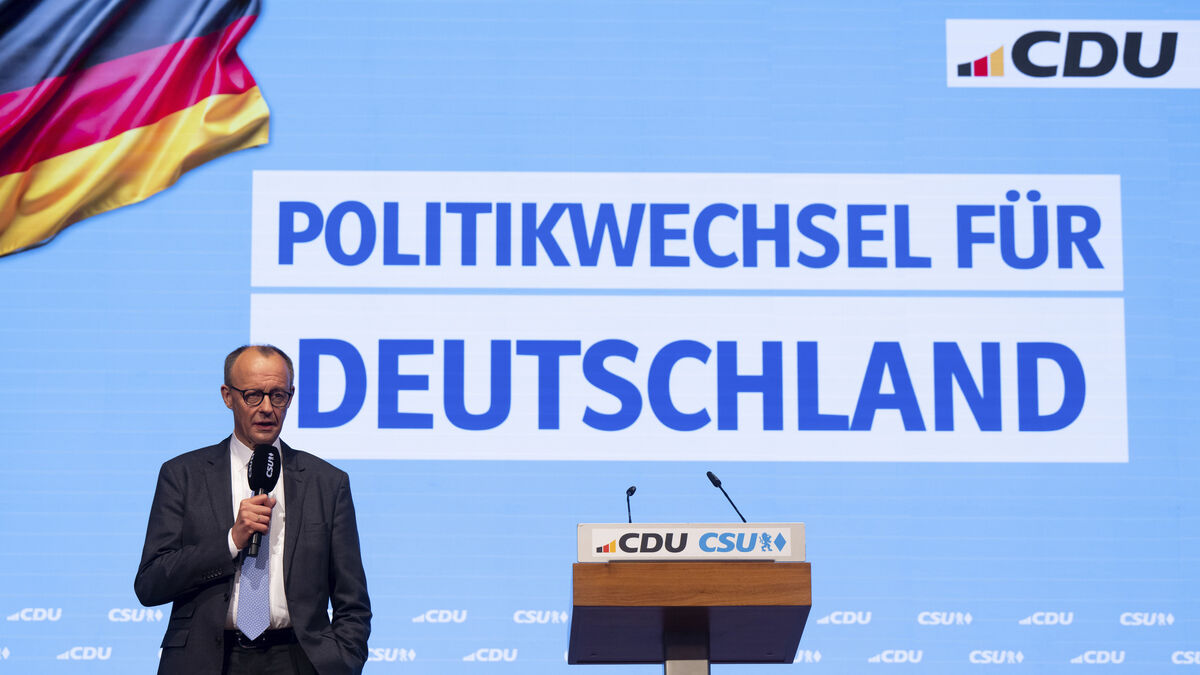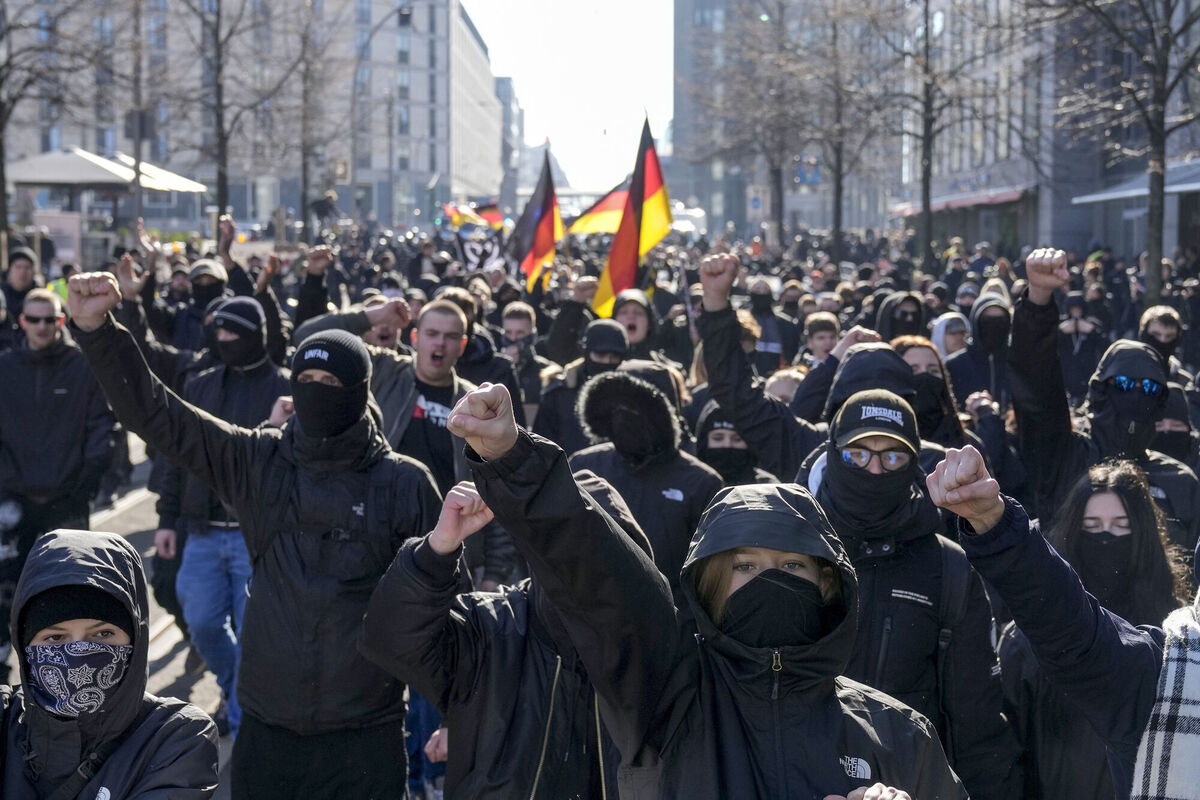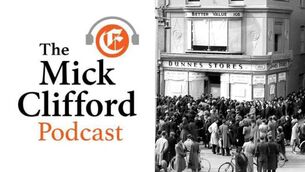Pessimism over state of the nation leads young Germans to extremes

Far-right supporters chant slogans at a protest in Berlin a day before the German elections last month. The SPD has lost most of the working class to the far right and competes with other left-leaning parties for the votes of professionals. Photo: AP/Ebrahim Noroozi
Back in November, the co-leader of the German Greens Franziska Brantner provided an explanation of why knitting has been so popular among delegates of their party conferences ever since the foundation of the party more than 40 years ago: it was all part of preparing for a winter election campaign.
That campaign is over, but in last Sunday’s election a considerable share of German voters left the traditional parties out in the cold. This happens at a time when the mood in Germany is pessimistic anyway.
The economy has shrunk for two consecutive years, energy costs are high, and structurally important sectors like the automobile industry face sluggish demand. After long periods of internal conflict, the unpopular “traffic light” coalition consisting of Social Democrats, Liberals and Greens collapsed on the day after Donald Trump won the US presidential election.
In the aftermath, the country has experienced the most polarized election campaign in a long time. Large segments of the population have been in favour of reducing immigration levels for some time.

The populist radical right Alternative for Germany (AfD) benefits from that sentiment, and opinion polls have been indicating a further upward trend for the party since last summer.
At the same time, many Germans are concerned about social cohesion, tolerance, and the threat to democracy posed by the far-right party. The car attack on a Christmas market in Magdeburg and the stabbing in Aschaffenburg in January (with a two-year-old child among the two fatalities), both committed by perpetrators with a migration background, reinforced those deep divides.
After taking over the leadership of the Christian Democrats (CDU/CSU) in early 2022, Friedrich Merz had steered the party towards the right both on economic and socio-cultural questions. Following the stabbing attack, the Christian Democrats pushed for stricter immigration policies in parliament, tabling initially a (non-binding) resolution, which passed only with the votes from the AfD.
A similar legislative bill did not find majority support, but the parliamentary proceedings exacerbated the conflict between parties and voters in favour of restrictions on immigration and those who interpreted the Christian Democrats' decision as a collaboration with the far right.
This move by the CDU/CSU sparked criticism even from actors that typically do not intervene into day-to-day politics: former chancellor (and party colleague) Angela Merkel and both the Catholic and the Protestant church of Germany. Subsequent street protests against the far right and its accommodation attracted large crowds across many different cities of the country.
Has the rightward shift worked for the Christian Democrats?
While the party topped the poll and Merz will likely be the next chancellor of Germany, the result of 28.6% of the vote is far from overwhelming. Along with the Social Democrats (SPD), the CDU/CSU is traditionally considered one of the two Volksparteien that used to attract a large share of voters from a broad variety of social backgrounds.
From that point of view, the over-time electoral decline of what used to be the two major parties resembles developments in Ireland.
Merz’s personal ratings also show considerable scope for improvement. While popular within his own party, where many welcomed his double rightward shift after the long centrist spell under Merkel, supporters of other parties are less enthusiastic. The skepticism is more pronounced among women, particularly younger women.
In addition, Merz still has to demonstrate that he is up to the top job, since he has oddly enough never served in a ministerial role at the national or state level before.
Having said that, the SPD is certainly in a more difficult position. Olaf Scholz has led a government with low satisfaction ratings for most of its duration.
The three-party coalition of SPD, Liberals and Greens could easily agree on a number of reforms in the socio-cultural realm (such as simplifying the requirements for obtaining German citizenship and legalizing cannabis). However, it was clear from the beginning that the three parties’ views on economic policy, especially the trade-off between public spending and taxes, would be hard to bridge.
This problem was subsequently exacerbated by the economic consequences of the Ukraine war and a court ruling that further restricted the scope of fiscal manoeuvres compliant with the so-called debt brake that is part of Germany’s constitution.
The perception of disunity and infighting also raised questions about Scholz’ leadership qualities. To many, the image of the calm and prudent decision-maker became that of a waverer who stood by watching things getting out of control.
However, for the SPD there are also issues that go beyond the question of government performance. Like other Social Democratic parties in Europe, it has lost most of the working class to the far right and competes with other left-leaning parties for the votes of professionals.
Looking at the smaller parties, two of them are clear losers. This is particularly the case for the Free Democrats (FDP), who promote liberal positions both on economic and socio-cultural matters.
As in 2009, by staying short of the 5% threshold, the party will transition straight from being a government member to being an extra-parliamentary party.
It is plausible to assume that a key factor contributing to this defeat was its role in bringing down the three-party coalition – Scholz eventually dismissed the Minister of Finance and party leader Christian Lindner, which led the FDP to leave the government.
Clashes within the cabinet frequently occurred between the FDP and the Greens. Tensions between pro-business interests favouring a leaner State and pro-environmental interests more strongly supporting regulatory frameworks are of course also familiar from an Irish context.
The Greens obtained 11.6% of the vote, down 3.1 percentage points compared to four years ago. From among the three parties, they got away best from participating in government.
However, the requirement for centrist compromises, including in the area of immigration, in the previous term, plus the openness towards forming a government coalition with the CDU/CSU in the new term, made them lose votes to left-wing competitors. A continuing role in government is now very unlikely.
CDU/CSU and Greens together do not control a majority of seats, and parts of the Christian Democrats, especially the more strongly conservative Bavarian CSU, oppose such a coalition anyway. As we have also observed in the Irish context, there appear to be more compatible and convenient partners for the centre-right than the Greens.
Looking for the clear winners of this election, these can be found at the extremes of the political spectrum. On the right end, the AfD doubled its vote share and reached 20.8%, with a programme promoting anti-immigration, socio-culturally conservative and economically liberal to libertarian views.
The spectrum of views found in the party also stretches to the extreme right, and it is monitored by intelligence services for that reason. As in previous elections, there is a pronounced difference in AfD support between West (17.9%) and East Germany (34.5%). Interestingly, many citizens now perceive the AfD also as the party that best represents East German interests.
If a CDU/CSU-SPD coalition forms, the AfD will be the largest opposition party in the new Bundestag. This is not a first (it already was in this position after the 2017 election), but the considerably larger seat share now implies more State funding and more extensive speaking rights (a much-valued good for the opposition, as we know).
The other parties expressed commitment to maintain the so-called firewall to cordon off the AfD. That means there is no hope of access to government for the party, at least in the short run. At the same time, any new government can expect relentless criticism from the far right and needs to think about new ways of countering and containing this opposition.
The biggest surprise of this election is the performance of The Left, with 8.8% of the national vote. For a long time, the economically and socio-culturally left-wing party had been characterized by internal divisions.
Its charismatic former parliamentary group co-leader eventually formed her own party, Sahra Wagenknecht Alliance (BSW), seeking to combine pro-redistribution positions with immigration-skeptic, socio-culturally conservative and anti-Green views.
Squeezed by both the AfD and the new competitor BSW, which performed strongly in three 2024 East German state-level elections and even entered two of the resulting governments, The Left struggled for its survival.
Since the beginning of 2025, though, it has experienced a strong surge in the polls. Part of the explanation is that its pro-immigration position became a unique feature that attracted voters from other parties, as even the Greens had become somewhat more immigration-skeptic.
The Left also ran an intensive campaign, both knocking doors offline and using social media to reach out to other groups.
Ironically, BSW managed to secure only 4.97% of the vote in the Bundestag election and very narrowly missed the 5% threshold.
Not only did it fail to gain representation in the new parliament, this also facilitates a two-party coalition of CDU/CSU and SPD, which can command a majority of seats with a combined 45% of the votes.
Exit polls revealed that patterns of voting behaviour are quite different among younger cohorts, particularly as it relates to centrist parties and those at the far ends of the political spectrum.
Among 18- to 24-year-olds, the centrist parties CDU/CSU and SPD attracted only 13% and 12% of the vote, respectively. While the AfD vote in the youngest segment of the electorate is the same as overall with 21%, it is noteworthy that the party has considerably improved its performance in this group compared with the election four years ago (+14 percentage points). Most notably, The Left is very strong in this age group, with 25% in this group.
This raises the question of why so many young people are attracted to the far ends of the spectrum.
Social media is widely believed to play a big role here. Both AfD and The Left are known to be very active in these channels, and sure young people spend a lot of time on Instagram, TikTok and the likes. This explanation is of course plausible, but we also need to be careful with drawing premature conclusions.

First, those who use social media for political information do not necessarily use this channel only. Second, the content and style of the message matter as well. While Sahra Wagenknecht is also very prominent on social media, BSW’s vote share in the group of youngest voters is more or less the same as overall. BSW’s self-declared “anti-woke” positions on socio-cultural questions and immigration likely resonate less well among younger voters.
In addition, The Left’s female frontrunner candidate Heidi Reichinnek, who is credited for much of the party’s online success, has an occupational background in youth support services, which may explain why she is particularly skilled in connecting to younger people.
Third, the popularity of specific parties among the younger generation may well be of a transitional nature. In the 2021 election, it was the FDP and the Greens that stood out in terms of their popularity with the youth.
We know that party identification, as inferred from surveys asking people whether they feel close to a particular party, is less common among younger than older generations (Germany: 40% v 52%, Ireland: 20% v 41%; figures for 18- to 30-year-olds).
Even more remarkably, the youth vote in the Bundestag election was strongly gendered. The far-right AfD is more popular among 18- to 24-year-old men than women (27% v 15%; overall: 24% v 18% ), whereas The Left performs better among female (35%) than male (16%) voters in that group (overall: 11% v 7%).
At least to some extent, this reflects differences in policy views and attitudes. For example, young German women (18 to 30 years old) are more likely to support income redistribution than men (77% v 65%), and are less likely to agree with the statement that “Obedience and respect for authority are the most important values children should learn” (49% v 61%).

Interestingly, such strong differences cannot be found for the same age group in Ireland. Both the support for redistribution (84% for women, 82% for men) and the importance attached to authority (50% agreement by women, 55% by men) are more similar among younger Irish people of different genders.
Hence, while there are some parallels that may explain the low appeal of centrist parties to younger cohorts in Germany and Ireland, the solutions for those parties may not be the same.
- Dr Thomas Däubler is based in the School of Politics and International Relations at UCD and specializes in Comparative Politics and Research Methodology















